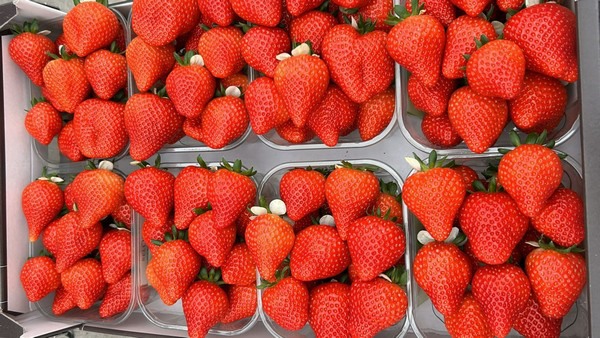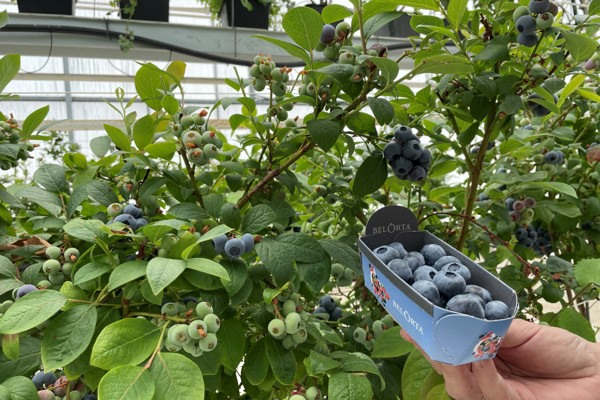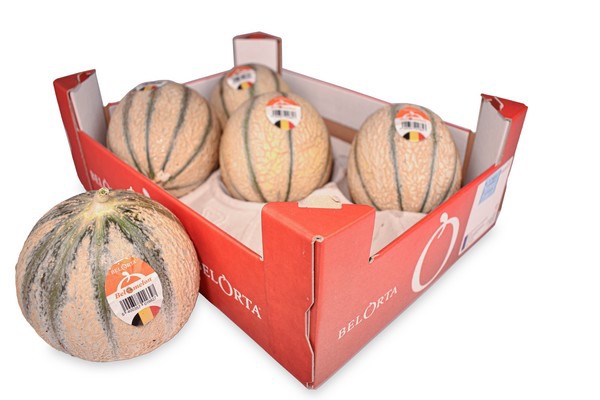Six types of soft fruit dominate during the summer season at BelOrta, alongside cherries. "In Africa, you look for 'The Big Five,' but here in Belgium, besides strawberries, we have our 'Small Five,'" laughs Miguel Demaeght, Head of the Fruit Division at BelOrta. It's a good time to reflect on the impact of a turbulent summer on these soft fruit varieties as we head into autumn.
If the other fruits are considered 'The Small Five,' strawberries remain the lion of the cooperative. "They continue to be our biggest product in the soft fruit category, but this summer presented significant challenges," Miguel begins. "It's always remarkable that we manage to maintain a good supply each year. As a grower, you need to have thick skin given all the challenges faced in recent years, and this year was no exception. It's especially disappointing to see strawberries experiencing difficult pricing from late July to early August. We often see fluctuations, but this year, in my opinion, the tough period lasted just a bit too long."

"But you can't control that, can you?" Miguel sighs. "We know many people are on vacation during this period, and several domestic supermarkets that had strawberry promotions in May, June, and early July stopped those by the end of July. When you also have additional volumes due to the weather, it can severely impact pricing. That was quite challenging for a while, but I must say that we've been back to good price levels for about three weeks now. There's currently a dip in supply, which has pushed prices back up to very high levels over the past two weeks. This could help retain customers when more volume becomes available again. It shows just how quickly things can change in the strawberry market."
On the demand side, Miguel observes a slight shift as well. "We have two main sources of demand. On one hand, there's the domestic market. Belgium remains our home market and is still the most important one. It always sells well, but you can see that retail shelves are starting to change during this period. Strawberries are making way for peaches, nectarines, and early top fruit. Right now, there are fewer strawberries, but we expect demand to pick up again in a week or two. Heading into autumn, we usually see a lot more production from the Netherlands and Belgium directed towards exports compared to the spring. In terms of destinations, BelOrta aims for a good distribution across various European countries."

Few issues among the small five
But what about the other five products in "The Small Five"? "We're talking about raspberries, blackberries, blueberries, red currants, and gooseberries. The gooseberry season wrapped up at the beginning of August. While it's often described as a niche product, it's certainly not for us. In a good year, we harvest around 60 to 70 tons, primarily for the Belgian market, where we find that these berries make a great addition to the soft fruit offering. This season has been strong again, making it an important product group for us."
"Looking at red currants, we're also satisfied," Miguel continues. "This year, we had slightly lower volumes due to the weather during the spring setting, but the quality is excellent. The season is progressing well. We see a similar situation with blueberries, which are now gradually coming to an end. We still have two growers supplying later varieties, but that will also wrap up in about a week or two. This timing is ideal because the first Peruvian berries are starting to arrive by air. Soon, the first shipments by sea will set sail, allowing us to exit the market before the cheaper competition from Peru arrives."

"Blackberries are one of the products where we see a relatively stable demand, supply, and pricing. About six years ago, we experienced significant price fluctuations during the blackberry season, but that has diminished. This stability is largely due to the strong export performance of our Belgian blackberries, which are of high quality. Many consumers still haven't tried blackberries, so consumption is gradually increasing. Given the steady supply, we have reasonable pricing. We expect to continue with blackberries until around Christmas."
Finally, there are raspberries. "They faced quite a bit of difficulty until about two weeks ago, with an oversupply in the market—not just from Belgium, but from the Netherlands, Germany, France, and Portugal. This surplus led to plummeting prices. However, things seem to have stabilized now. Ultimately, we hope this stability lasts for the next six weeks, allowing us to finish the season on a positive note and compensate for the earlier challenges."
Distinguished in local products: BelOmelon and BelOplum
It has been a busy summer for the cooperative, always striving to offer a comprehensive selection of soft fruit. "As a local cooperative, we think it is important to offer beautiful local products. Not only the known fruit varieties but also new types that customers can differentiate themselves with. Take the gooseberry, for example. We know it demands shelf space, and we often wonder if that space is justified. However, when we see how much this product is appreciated by Belgian retailers and consumers, it becomes clear that it's significant for us. They want to offer something special and deliciously local, and we aim to add value by seeking out these unique products."

"We always keep an eye out for potential new products," Miguel explains. "About four years ago, we launched two projects. One is the BelOmelon project, where we aim to offer local Charentais melons and watermelons. Imported melons are harvested unripe due to their long journey, but we can harvest them with our growers at the perfect ripeness, ready to eat. This allows us to compete in flavor with imported products while also telling a great local story. It's been well-received. Ultimately, we won't drive Spanish or French melons off the shelves; it's not like strawberries, which are only Belgian during their season. With melons, we aim to be a complementary option. We're taking steps toward achieving a market share of 10 percent—that's the dream."
Another example is the BelOplum project. "This is a similar story. We started this initiative about four years ago because Belgian plums were on the brink of disappearing. Growers were quitting since retailers were reluctant to work with them, citing the short supply from local producers, who could only offer them for two weeks. It was a classic chicken-and-egg situation. So, we brought together growers and customers, which led to the creation of a brand for plums called BelOplum. Within this segment, we now produce and market early, mid, and late varieties that we can supply for about 7 to 8 weeks. Our ambition is to extend that to a full 10-week period. These are examples of how, alongside 'The Small Five,' we are exploring innovations to create added value for our customers."
For more information:![]() Miguel Demaeght
Miguel Demaeght
BelOrta
Mechelsesteenweg 120
2860 Sint-Katelijne-Waver, Belgium
Tel: +32(0)12 670 260
info@belorta.be
www.belorta.be
